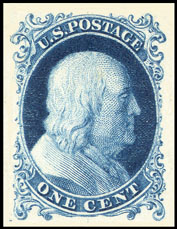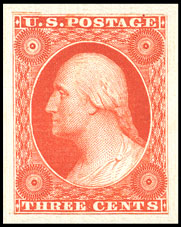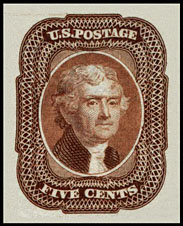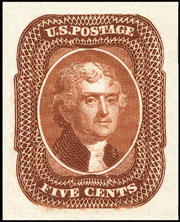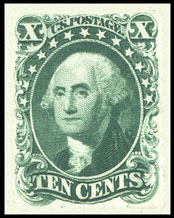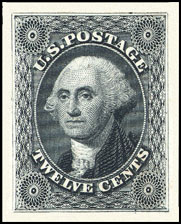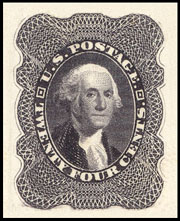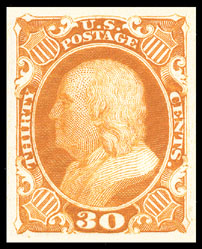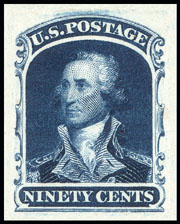
Designs of the U.S. Regular Issues of 1851-1860
Printed in sheets of 200 subjects with two side-by-side 10 x 10 panes of 100 stamps (except the 5¢ in which the 2 panes were vertical)Click on underlined Catalog Numbers below to see more details.
1¢ Franklin of 1851
Blue
Engravers: Vignette: Joseph I. Pease
Frame and Lettering: Henry Earle
| Year | Number | EDU | No. Issued* | Perf | Printer | Color - Plates | Type | Design Size | Usage | |
| 1851 | 5 | 7/5/1851 | ~35,000 | None | TCC | blue - plate 1E | I | 20 x 26 mm | The one cent stamp paid the rate for drop letters and circulars. This issue was printed from 11 Plates (plus a late state of plate 1) of 200 stamps each. Plates 1E, 1L, 2, 3 and 4 produced imperforate stamps. Plates 1L, 2, 4-5 and 7-12 produced perforated stamps. The plate and position of each stamp can be determined uniquely. |
|
| 1851 | 5A | 7/1/51(FD) | ~210,000 | None | TCC | blue - plate 1E | Ib | see note below | ||
| 1857 | 6 | 4/19/1857 | ~110,000 | None | TCC | blue - bottom row of plate 4 | Ia | -------- | ||
| --- | 6b | 5/20/1857 | ~60,000 | None | TCC | blue - plate 4 | Ic | -------- |
|
|
| 1851 | 7 | 7/1/51(FD) | ~12,300,000 | None | TCC | blue - plates 1E, 2, 3 and 4 | II | -------- | ||
| 1857 | 8 | 7/7/1857 off cover | ------- | None | TCC | blue - plate 4 | III | -------- | ||
| 1855 | 8 | --- | ------- | None | TCC | blue - plate 2 - pos. 99R2 | III | -------- | ||
| 1851 | 8A | 7/3/1851 | ~650,000 | None | TCC | blue - 1E, 2 and 4 | IIIa | -------- | ||
| 1852 | 9 | 6/5/1852 | ------- | None | TCC | blue - plate 1L (recuts) | IV | -------- | ||
| --- | 9a | --- | ------- | None | TCC | printed on both sides reverse inverted | IV | -------- | ||
| 1861 | 18 | 1/25/1861 | ------- | 15½ | TCC | blue - plate 12 | I | 20 x 26 mm | ||
| 1857 | 19 | 9/9/1857 | ~300,000 | 15½ | TCC | blue - plate 4 | Ia | -------- | ||
| --- | 19b | --- | ~150,000 | 15½ | TCC | blue - plate 4 | Ic | -------- | ||
| 1857 | 20 | 7/26/1857 | ------- | 15½ | TCC | blue - plates 2, 4, 11 and 12 | II | -------- | ||
| 1857 | 21 | 9/18/1857 | ~3,500 | 15½ | TCC | blue - plate 4 and pos. 99R2 | III | -------- | ||
| --- | 21a | --- | --- | 15½ | TCC | horizontal pair imperf. between | III | -------- | ||
| 1857 | 22 | 7/26/1857 | ------- | 15½ | TCC | blue - plates 4, 11 and 12 | IIIa | -------- | ||
| --- | 22b | --- | --- | 15½ | TCC | horizontal pair imperf. between | IIIa | -------- | ||
| 1857 | 23 | 7/25/1857 | ------- | 15½ | TCC | blue - plate 1L (recuts) | IV | -------- | ||
| 1857 | 24 | 11/17/1857 | ~50 million | 15½ | TCC | blue - plates 5, 7, 8, 9, 10 | V | -------- | ||
| 1857 | 24 | --- | ~200,000 | 15½ | TCC | blue - plate 5 | Va | -------- | ||
| --- | 24b | --- | --- | 15½ | TCC | laid paper | V | -------- | ||
| 1875 | 40 | n/a | 3846 | 12 - Continental | bright blue - reprint | I | 20 x 26 mm | |||
3¢ Washington of 1851
Orange Brown
Engravers: Vignette: Joseph I. Pease
Frame: (geometric lathe): Cyrus Durand Lettering: Henry Earle
| Year | Number | EDU/ Variety |
No. Issued* | Perf | Printer | Color - Plates | Type | Design Size | Usage | |
| 1851 | 10 | 7/1/51(FD) | est. 20 million | None | TCC | orange brown; plates 1E;1i | I | 20 x 25 mm |
|
|
| 1851 | 10A | 7/1/51(FD) | None | TCC | orange brown;1E, 1i, 2E, 5E, 0 | II | 20 x 25 mm | |||
| --- | 10Ab | printed on both sides | None | TCC | II | 20 x 25 mm | ||||
| 1855 | 11 | 3/28/1855 | ~ 340 million stamps were issued that would now be assigned as Scott 11 or Scott 11A | None | TCC | dull red; claret; rose red orange red, plum brownish carmine; pinkish plates 4, 6, 7, 8 |
I | 20 x 25 mm | ||
| 1857 | 11A | 10/6/1851 | None | TCC | dull red; brownish carmine; claret; rose red; orange red; experimental orange; plates 1L, 2L, 3, 5L | II | 20 x 25 mm | |||
| --- | 11Ac | vert. bisect on cover | None | TCC | II | 20 x 25 mm | ||||
| --- | 11Ad | diag. bisect on cover | None | TCC | II | 20 x 25 mm | ||||
| --- | 11Ae | double impression | None | TCC | II | 20 x 25 mm | ||||
| 1857 | 25 | 2/28/1857 | ~39 million | 15½ | TCC | rose; rose red, claret, dull red plates 4, 6, 7, 8 |
I | 20 x 25 mm | ||
| --- | 25b | vert. pair imperf. horiz. | 15½ | TCC | I | 20 x 25 mm | ||||
| 1857 | 25A | 4/15/1857 | --- | 15½ | TCC | rose; rose red, claret, dull red plates 2L, 3, 5L |
II | 20 x 25 mm | ||
| 1857 | 26 | 9/14/1857 | ~550 million | 15½ | TCC | dull red, red, rose brownish carmine, claret orange brown, plum plates 9, 12-28 |
III | 20 x 25 mm | ||
| --- | 26b | horiz. pair imperf. vert. | 15½ | TCC | III | 20 x 25 mm | ||||
| --- | 26c | vert. pair imperf. horiz. | 15½ | TCC | III | 20 x 25 mm | ||||
| --- | 26d | horiz. pair imperf between | 15½ | TCC | III | 20 x 25 mm | ||||
| --- | 26e | dbl. impress. | 15½ | TCC | III | 20 x 25 mm | ||||
| 1857 | 26A | 7/11/1857 | ~33 million | 15½ | TCC | dull red, rose, brownish carmine; claret; plates 10, 11 | IV | 20 x 25 mm | ||
| --- | 26Af | horiz. strip of 3, imperf. vert. on cover | IV | 20 x 25 mm | ||||||
| 1875 | 41 | --- | 479 | 12 - Continental | scarlet - reprint | I | 20 x 25 mm |
|
||
5¢ Jefferson of 1856-1859
Type I Brown
Engravers: Vignette: Joseph I. Pease
Frame (geometric lathe): Cyrus Durand Lettering: Henry Earle
| Year | Number | EDU | No. Issued | Perf | Printer | Color | Type | Design Size | Usage | |
| 1856 | 12 | 3/24/1856 | ~150,000 | None | TCC | red to dark red brown | I | 19½ x 25½mm |
|
|
| 1858 | 27 | 10/6/1858 | ~135,000 | 15½ | TCC | brick red | I | 19½ x 25½mm | ||
| 1857 | 28 | 8/23/1857 | ~270,000 | 15½ | TCC | red brown | I | 19½ x 25½mm | ||
| 1857 | 28b | --- | 15½ | TCC | bright red brown | I | 19½ x 25½mm | |||
| 1858 | 28A | 3/31/1858 | <50,000 | 15½ | TCC | indian red | I | 19½ x 25½mm | ||
| 1859 | 29 | 3/21/1859 | ~510,000 | 15½ | TCC | pale to deep brown, yellow brown | I | 19½ x 25½mm |
5¢ Jefferson of 1860-1861
Type II Orange Brown
Engravers: Vignette: Joseph I. Pease
Frame (geometric lathe): Cyrus Durand Lettering: Henry Earle
| Year | Number | EDU | No. Issued | Perf | Printer | Color | Type | Design Size | Purpose | |
| 1861 | 30 | 5/8/1861 | ~570,000 | 15½ | TCC | orange to deep orange brown | II | see Design Size below |
|
|
| 1860 | 30A | 5/4/1860 | ~825,000 | 15½ | TCC | yellow brown to brown to dark brown |
II | |||
| --- | 30Ab | --- | 15½ | TCC | printed on both sides | II | ||||
| 1875 | 42 | n/a | 878 | 12 - Continental | orange brown - reprint | II | The 5¢ reprint was issued as part of a set of Special Printings |
|||
10¢ Washington of 1855-1861
Green
Engravers: Vignette: Joseph I. Pease
Frame and Lettering: Henry Earle
| Year | Number | EDU | No. Issued | Perf | Printer | Color | Type | Design Size | Usage | |
| 1855 | 13 | 7/11/1855 | ~500,000 | None | TCC | yellowish green to dark green | I | 19 x 24¼ mm |
|
|
| 1855 | 14 | 5/12/1855 | ~2,300,000 | None | TCC | yellowish green to dark green | II | see note below | ||
| 1855 | 15 | 5/19/1855 | ~2,000,000 | None | TCC | yellowish green to dark green | III | -------- | ||
| 1855 | 16 | 6/4/1855 | ~200,000 | None | TCC | yellowish green to dark green | IV | -------- | ||
| 1857 | 31 | 8/25/1857 | ~600,000 | 15½ | TCC | yellow- to blue- to dark green | I | 19 x 24¼ mm | ||
| 1857 | 32 | 7/27/1857 off cover |
~2,900,000 | 15½ | TCC | yellow- to blue- to dark green | II | see note below | ||
| 1857 | 33 | 8/8/1857 | ~2,400,000 | 15½ | TCC | yellow- to blue- to dark green | III | -------- | ||
| 1857 | 34 | 10/5/1857 | ~240,000 | 15½ | TCC | yellow- to blue- to dark green | IV | -------- |
|
|
| 1859 | 35 | 4/29/1859 | ~12,000,000 | 15½ | TCC | yellow- to dark green; 2nd plate | V | -------- | ||
| 1875 | 43 | n/a | 516 | 12 - Continental | blue green - reprint | I | 19 x 24¼ mm | |||
12¢ Washington of 1851-1861
Grey Black
Engravers: Vignette: Joseph I. Pease
Frame (geometric lathe): Cyrus Durand Lettering: Henry Earle
| Year | Number | EDU | No. Issued | Perf | Printer | Color | Type | Design Size | Usage | |
| 1851 | 17 | 8/4/1851 | ~2,500,000 | None | TCC | gray black to intense black | plate I | 20 x 25 mm |
|
|
| --- | 17a | --- | None | TCC | diag. half on cover | plate I | 20 x 25 mm | |||
| --- | 17b | --- | None | TCC | vert. half on cover | plate I | 20 x 25 mm | |||
| --- | 17c | --- | None | TCC | printed on both sides | plate I | 20 x 25 mm | |||
| 1857 | 36 | 7/30/1857 | ~3,000,000 | 15½ | TCC | gray black to black | plate I | 20 x 25 mm | ||
| --- | 36a | --- | --- | None | TCC | diag. half on cover | plate I | 20 x 25 mm | ||
| --- | 36c | --- | --- | None | TCC | horizontal pair imperf. between | plate I | 20 x 25 mm | ||
| 1859 | 36B | 6/1/1860 | --- | 15½ | TCC | black to intense black | plate 3 | 20 x 25 mm | ||
| 1875 | 44 | 44 | n/a | 489 | 12 - Continental | greenish black - reprint | 20 x 25 mm | The 12¢ reprint was issued as part of a set of Special Printings | ||
24¢ Washington of 1860-1861
Grey Lilac
Engravers: Vignette: Joseph I. Pease
Frame (geometric lathe): Cyrus Durand Lettering: Henry Earle
| Year | Number | EDU | No. Issued | Perf | Printer | Color | Type | Design Size | Usage | |
| 1860 | 37 | 7/7/1860 | 740,000 | 15½ | TCC | gray lilac to red lilac | ---- | 19¼ x 25 mm | The 24¢ stamp saw common usage on letters to Great Britain. It was also used in combination with other stamps to make up a higher rate | |
| --- | 37a | --- | 15½ | TCC | gray | ---- | 19¼ x 25 mm | |||
| 1875 | 45 | n/a | 479 | 12 - Continental | blackish violet - reprint | ---- | 19¼ x 25 mm |
|
||
30c Franklin of 1860-1861
Yellow Orange
Engravers: Vignette: Joseph I. Pease
Frame and Lettering: Henry Earle
| Year | Number | EDU | No. Issued | Perf | Printer | Color | Type | Design Size | Usage | |
| 1860 | 38 | 8/8/1860 | 360,000 | 15½ | TCC | yellow orange to red orange | ---- | 20 x 25 mm |
|
|
| 1875 | 46 | n/a | 480 | 12 - Continental | yellow orange - reprint | ---- | 20 x 25 mm |
|
||
90c Washington of 1860-1861
Blue
Engravers: Vignette: Joseph I. Pease
Frame and Lettering: Henry Earle
| Year | Number | EDU | No. Issued | Perf | Printer | Color | Type | Design Size | Usage | |
| 1860 | 39 | 9/11/1860 | 25,000 | 15½ | TCC | blue to deep blue | ---- | 19 x 24½ mm |
|
|
| 1875 | 47 | n/a | 454 | 12 - Continental | deep blue - reprint | ---- | 19 x 24½ mm |
|
||
Quantity issued:
Estimates are based on available information, primarily from Brookman, "The United States Postage Stamps of the 19th Century- Volume I", "Linn's U.S. Stamp Facts 19th Century", published by Linn's Stamp News and Chase's "The Three Cent Stamp of the United States 1851-1857- Revised". These numbers are simply estimates based on the best information available and are subject to revision.
The 3¢ imperforate quantity issued is based on an estimated 360,000,000 stamps printed, with the vast majority being from the later plates. The best way to determine whether a stamp is an early, Scott 10 and 10A, or later printing, Scott 11 or 11A, is to determine which plate it was printed on. While it is true that most of the earlier printings are a shade of orange brown, it is not the color that determines the variety, it is the plate. The early printings were printed on plate 0, the early and intermediate plate 1 and the early plates of plates 2 and 5. The later variety was printed on the late plates of plates 1, 2 and 5, as well as plates 3, 4, 6, 7 and 8. In general, the early printings are much sharper than the later printings.
Design Size on the 1¢, 5¢ and 10¢ Stamps: All varieties other than type I have been at least partially cut away, sometimes on all four sides and to varying degrees within a particular type depending on plate position. This was done to make the design fit within the allocated space on the plate leaving adequate margins for separation. This was particularly true when adding perforations to the finished sheets became standard practice in 1857. Since the design width and height varied from stamp to stamp, even within a particular type, design measurements for the various types are meaningless.
Special Printings: The following information applies to all of the 1851 reprints. The Special Printings were issued to showcase a complete set of the U.S. issues for the first World's Fair officially held in the U.S., at the Centennial International Exposition of 1876 in Philadelphia and also to provide stamps for collectors and others to satisfy numerous requests. While "Reissued" stamps were valid for postage, "reprints" were not, since the series was demonetized in 1861. All of the 1851 reprints are easily identifiable by their gauge 12 perforations versus the gauge 15 of the regularly issued stamps.
Bibliography and suggested additional reading:
The Postage Stamps of the 19th Century, Volume 1, by Lester Brookman (1966)
The 1851 Issue of United States Stamps, Sesquicentennial Retrospective Hubert Skinner, Charles Peterson editors (USPCS 2006)
The 2011 Scott Specialized Catalogue of United States Stamps & Covers, Scott Publishing Co. 2010
United States Letter Rates to Foreign Destinations 1847 to GPU-UPU, by Charles J. Starnes
The United States One Cent Stamp of 1851-1857, by Stanley Ashbrook 2 volumes (1938)
The United States One Cent Stamp of 1851-1861, by Mortimer Neinken (1972)
The Three Cent Stamp of the United States 1851-1857 Issue, by Dr. Carroll Chase (Quarterman Reprint 1975)
The United States 3c Issue of 1851-1861: A Progress Report, by T. J. Alexander (39th Am. Philatelic Congress 1973)
The U.S. Five Cent Stamp of 1856: The Frederick R. Mayer Collection, by Richard C. Frajola & Frederick R. Mayer (2005)
The United States 5c Stamps of 1856-1861, by Henry Hill
The United States Ten Cent Stamp of 1855-1857, by Stanley Ashbrook (1936)
The United States Ten Cent Stamp of 1855-1859, by Mortimer Neinken (1960)
United States Twelve Cent Stamp of 1851-1857, by Stanley Ashbrook (1926)
The United States Twelve Cent Stamp of 1851-1857, by Mortimer Neinken (1964)
Plate Varieties of the United States Twenty-four Cent 1860, by Elliott Perry (17th Am. Philatelic Congress 1951)
The United States Ninety Cent Stamp of 1860 On and Off Cover, by S. Ashbrook (17th Am. Philatelic Congress 1951)
Design dimensions:
The Postage Stamps of the United States, John Luff (1902 and 1937)
Colors:
The Encyclopedia of the Colors of United States Postage Stamps - Volume 1 Issues of 1847-1868, by Roy H. White (1981)
Postal History:
United States Letter Rates to Foreign Destinations 1847 to GPU-UPU, by Charles J. Starnes
The U.S. Five Cent Stamp of 1856: The Frederick R. Mayer Collection, by Richard C. Frajola & Frederick R. Mayer (2005)
History of Letter Post Communication between the United States and Europe, by George E. Hargest
Plating:
Notes on the plating of the 10¢ stamp were published by Elliott Perry in the Collector's Club Philatelist from 1924-1926. Perry's plating of this stamp is considered one of the great milestones in the hobby.
Additional Resources
Year In Stamps - 1851 Year In Stamps - 1855 Year In Stamps - 1857 Easy ID 1851-58 10c Types The Collectors Club U.S. Classic Postal Issues Doporto Plating Archive 1851 1C Siegel Auction 3¢ 1851-57 Plating Project 5¢ stamp of 1856 Frajola 5C Jefferson USPCS 10C Washington NPMBrookman PDF download
Chase PDF Download
